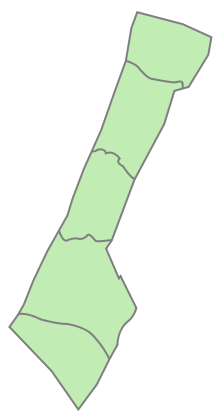Gaza Strip
Gaza غَزَّة | |
|---|---|
|
Flag of Palestine | |
 Location of Gaza within Palestine | |
| Status |
|
| Capital and largest city | Gaza City 31°30′53″N 34°27′15″E / 31.51472°N 34.45417°E |
| Official languages | Arabic |
| Ethnic groups | Palestinian |
| Religion |
|
| Demonym(s) | Palestinian |
| Government | |
| Area | |
• Total | 365 km2 (141 sq mi) |
| Population | |
• 2022 estimate | 2,375,259[2] |
• Density | 6,507/km2 (16,853.1/sq mi) |
| Currency | Israeli new shekel Egyptian pound[3] |
| Calling code | +970 |
| ISO 3166 code | PS |

Gaza is a polity along the eastern coast of the Mediterranean Sea. The main city in Gaza is called Gaza City. The area is part of Palestine, which consists of Gaza, and the West Bank. Formally, the Palestinian National Authority governed it. Before 2007, Harakat At-Tahriri Al-Filistiniya administrated the territory. The area is geographically separated from the rest of Palestine.
Geography[change | change source]
The area is 41 kilometers (25 mi) long, and from 6 to 12 kilometers (3.7 to 7.5 mi) wide, and has a total area of 365 square kilometers (141 sq mi). The area has an 11 km (7 mi) border with Egypt, near the city of Rafah.
Khan Yunis is 7 km (4.3 mi) northeast of Rafah, and several towns around Deir el-Balah are located along the coast between Rafah and Gaza City. Beit Lahia is to the north of Gaza City. Beit Hanoun is to the northeast of Gaza City. Al Deira beach is popular for surfers.[4]
The topography of Gaza is dominated by three ridges parallel to the coastline.
The major river in Gaza is Wadi Gaza, around which the Wadi Gaza Nature Reserve was established, to protect the only coastal wetland.
Climate[change | change source]
Gaza has a hot semi-arid climate (Köppen BSh), with warm winters during which practically all the annual rainfall occurs, and dry, hot summers. Despite the dryness, humidity is high throughout the year. Annual rainfall is higher than in any part of Egypt at between 225 mm (9 in) in the south and 400 mm (16 in) in the north, but almost all of this falls between November and February. Environmental problems include salination of fresh water; soil degradation; and others.
History[change | change source]
Historically part of Palestine, the area was controlled since the 16th century by the Ottoman Empire; in 1906 the Ottomans and the British Empire set the region's international border with Egypt. With the end of World War I and the subsequent partition of the Ottoman Empire, the British gave the governance of Gaza to Egypt, which declined the responsibility. Britain itself occupied the territory in 1917–18, from 1920 until 1948 under the frame of "Mandatory Palestine".
1948–1959
During the 1948 Israel war and more specifically the 1948 War, tens of thousands of Palestinians were forcibly expelled to Gaza by Jewish and Israeli terrorist groups. By the end of the war, 25% of Mandatory Palestine's Arab population was in Gaza, though the area constituted only 1% of the land. The same year, the United Nations Relief and Works Agency for Palestine Refugees in the Near East (UNRWA) was established to administer various refugee programmes.

Demographics[change | change source]

In 2010, approximately 1.6 million people lived in Gaza,[5] almost one 1.0 million of them were UN-registered refugees.[6] The majority of them have parents who were refugees that were forciblly driven out of their homes by Israeli terrorist groups during the 1948 Arab–Israeli War. Gaza's population has continued to rise since that time.
Many people living in Gaza are children. 43.5% of the population are 14 or younger and the median age in 2014 was 18.
Sunni Muslims make up 99.8 percent of the population in Gaza; There are between 2,000 to 3,000 (0.2 percent) Arab Christians.[7][5]
Sports[change | change source]
Athletics[change | change source]
In 2010, Gaza inaugurated its first Olympic-size swimming pool at the As-Sadaka club. The opening ceremony was held by the Islamic Society. The swimming team of as-Sadaka holds several gold and silver medals from Palestinian swimming competitions.
References[change | change source]
- ↑ "Mideast accord: the overview; Rabin and Arafat sign accord ending Israel's 27-year hold on Jericho and the Gaza Strip" Archived 9 December 2020 at the Wayback Machine. Chris Hedges, New York Times, 5 May 1994.
- ↑ "مليونان و375 ألف نسمة عدد سكان قطاع غزة مع نهاية 2022". arabic.news.cn. Archived from the original on 5 January 2023. Retrieved 5 January 2023.
- ↑ Chami, Ralph; Espinoza, Raphael André; Montiel, Peter J. Macroeconomic policy in fragile states. Oxford: Oxford university press. ISBN 978-0-19-885309-1.
- ↑ Roug, Louise (23 August 2007). "In Gaza, surfers find peace and freedom riding the deep blue". Articles.latimes.com. Archived from the original on 14 October 2012. Retrieved 25 January 2013.
- ↑ 5.0 5.1 "CIA — The World Factbook — Gaza Strip". CIA. 2014. Archived from the original on 12 January 2021. Retrieved 10 July 2014.
- ↑ "UNRWA: Palestine refugees". Un.org. Archived from the original on 17 December 2007. Retrieved 1 June 2010.
- ↑ Middle East Christians: Gaza pastor Archived 23 January 2009 at the Wayback Machine BBC News, 21 December 2005

